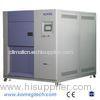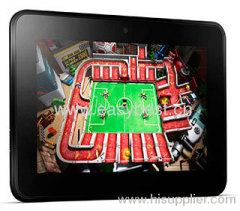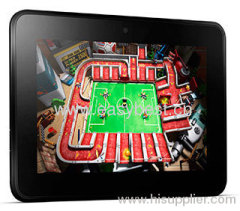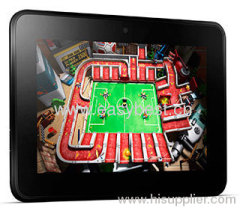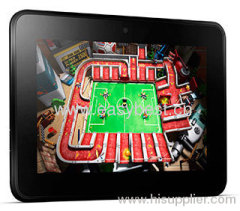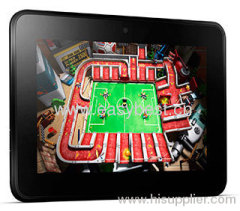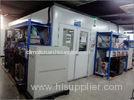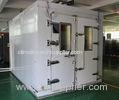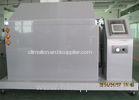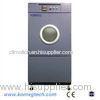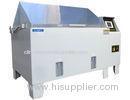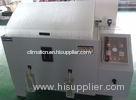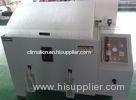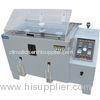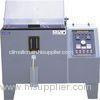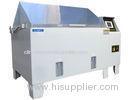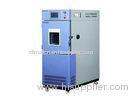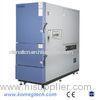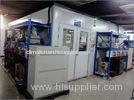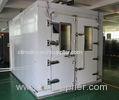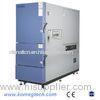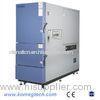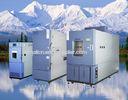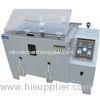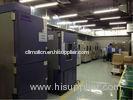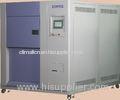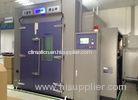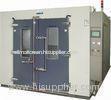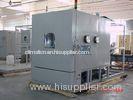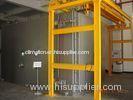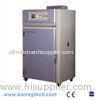|
KOMEG Technology Ind Co., Limited
|
High Stability Explosion Proof Lock 72L ESS Chamber 3 Zone Thermal Shock Chamber
| Place of Origin: | Zhejiang, China (Mainland) |
|
|
|
| Add to My Favorites | |
| HiSupplier Escrow |
Product Detail
High Stability Explosion-proof Lock 72L 3-Zone Thermal Shock ESS Testing Chamber
</p
High Stability Explosion-proof Lock 72L 3-Zone Thermal Shock ESS Testing Chamber
The air-to-air design utilizes preconditioned hot and cold chambers and then transfers the DUTs rapidly between them to accomplish thermal cycling. This design also permits overconditioning (spiking) of the chambers slightly beyond the required temperature extremes to hasten the speed at which the DUT achieves its target temperature. Because current ESS guidelines are recommending temperature transition rates of 20°C per minute, the air-to-air shock chamber is the preferred design.
1. Description and Application
As we know that thermal shock occurs when a thermal gradient causes different parts of an object to expand by different amounts. This differential expansion can be understood in terms of stress or of strain, equivalently. At some point, this stress can exceed the strength of the material, causing a crack to form. If nothing stops this crack from propagating through the material, it will cause the object's structure to fail. Normally we use thermal shock test equipment to test how much amount can a product withstand thermal shock.
Thermal shock testing exposes products to alternating low and high temperatures to accelerate failures caused by temperature cycles or thermal shocks during normal use. The transition between temperature extremes occurs very rapidly, greater than 15 °C/min.
2. Working Principle
There are three chambers used to perform thermal shock testing, high-temperature chamber, low-temperature chamber and test chamber. Sample is placed in the test chamber, more extreme temperature than test temperature can be set in high-temperature chamber and low-temperature chamber. When doing low temperature testing, cold chamber door open, and low-temperature chamber working together with test chamber.
When converted into high-temperature test, cold chamber door closed, hot chamber door are opened, and test chamber working together with high-temperature chamber. Conversion of mechanical action (transferring from high temperature to low temperature or low temperature to high temperature) can be completed in less than 1second, and the temperature can be quickly stabilized.
During the whole test, test sample is no need to be moved, and without any human intervention.


3. Specification
(1) KTS-A Series
|
Model |
|
||||||||
|
72A |
100A |
150A |
200A |
252A |
300A |
480A |
|||
|
Inside size(mm) |
W |
450 |
500 |
600 |
670 |
700 |
800 |
800 |
|
|
H |
400 |
450 |
500 |
600 |
600 |
600 |
800 |
||
|
D |
400 |
450 |
500 |
500 |
600 |
650 |
750 |
||
|
Outside size(mm) |
W |
1490 |
1540 |
1640 |
1720 |
1750 |
1850 |
1850 |
|
|
H |
1790 |
1840 |
1890 |
2000 |
2000 |
2000 |
2200 |
||
|
D |
1600 |
1700 |
1830 |
1850 |
1930 |
1980 |
2500 |
||
|
Test weight |
5 |
10 |
12 |
15 |
18 |
20 |
20 |
||
|
Low Temp Chamber |
-55ºC-10ºC, Pre cooling time: ≤ 60 min from +20ºCto-55ºC |
||||||||
|
Test Chamber |
-40ºC+150ºC |
||||||||
|
High Temp Chamber |
+60ºC+200ºC ,Within 20 min, Pre-heating time |
||||||||
|
Transition time |
≤15S |
||||||||
|
Recovery time |
High-Temp Exposure 30 min to reach & stabilize required hot temp of test sample |
||||||||
|
Low-Temp Exposure 30 min to reach & stabilize required cold temp of test sample |
|||||||||
|
≤ 5 min |
|||||||||
|
Ambient Temp. |
+5ºC+35ºC |
||||||||
|
Power |
AC 380±10 50Hz ,3 phase 4 wires +Ground Wires |
||||||||
(2) KTS-B Series
|
Model |

